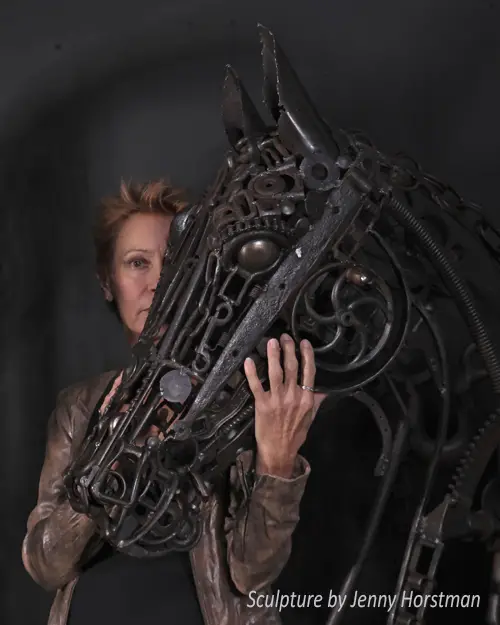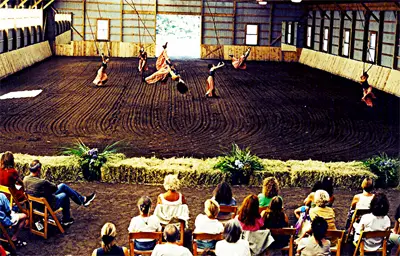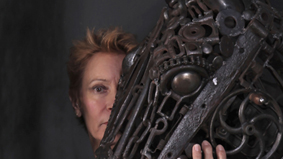As an artist, Paula Josa-Jones is a master of many creative forms…writer, dancer, teacher, coach, director and equestrian, and an amazing woman who shared some of her journey through midlife with Fifty Is The New Forty. The unique performance art of horse dancing is at the core of her creativity… integrating equition and dance into something other-wordly yet somehow familiar.
50/40: There are so many sides to who you are and what you do. What do you consider to be your true core passion: dancer, choreographer, educator, director, writer, or equestrian?
PJJ: Well this is what I say on my website: “My writing, dancemaking, teaching, coaching and work with horses are all part of the whole cloth of my practice as a movement artist. My goal is to help people connect to their creativity, to improvisation as a life practice, and to their own delicious and unique experience of embodiment.”
That theme of embodiment – of connecting inner and outer is probably my mission statement, both for myself and for others. I want to support a playful, conscious sense of embodiment that helps my students and clients discover a more balanced and joyful life. This seems to be a particularly disembodied time – thanks to the predominance of computers and digital communication. For me, a rich sense of aliveness is rooted in touch and movement, living with a sense of improvisation and feeling one’s sensual connection and relatedness to the earth and each other. I include in that each other all species. My most embodied moments are with my horses. You cannot be around a horse without paying attention. They are mirrors – like 1200lbs of fully awake biofeedback.
50/40: Horse dancing is a distinctly unique performance art…who introduced you to it, and what draws to you it?
PJJ: It really came from riding. I had come back to riding in midlife and pretty quickly realized that I wanted a bigger connection with horses, not just sitting on them, although that continued to be important and still is. So I started to play with dance and horses by inviting some members of my company down to Martha’s Vineyard, which was where I was living at the time. Very quickly we realized we had something unique and potent. The result was RIDE – an evening length work that premiered at the Red Pony Farm on Martha’s Vineyard. Things just continued on after that. At first, I wanted to do something bigger with RIDE. There were long conversations with Columbia Artists about the possibilities of a Vegas show. All of that fell apart because I do not think that it was right action for me or ultimately and most importantly, for the horses. Any time you are “using” animals, there must be a very high consciousness of their participation, their agreement, their sense of voice and enjoyment. That is a question I ask each step along the way in both dancing with them and riding. Each time I lead my horse from the barn to the arena, that is the beginning of a dance in which I invite and include my horse partner, whether we are dancing or taking a long walk in the field. Recently I have been studying with cowboy and Aikido master Mark Rashid. Bringing the softening, allowing quality of Aikido into my body has been revelatory, even for this very seasoned, very experienced mover!
50/40: Did you ever begin to feel differently about your work or your art as you entered midlife?
PJJ: The body, the body, the body! One of my biggest struggles was physical. In my 40’s, I began to lose a lot of mobility because my hips were shot. I wrote this at the time:
“Suddenly, there is pain – a twinkling, deep persistent pain in my sacrum. I thought it would go away. It did not. I was afraid. I tried to find someone who could help me. It did not go away. It stayed. It had moved into my body taken up residence. My performer self began to recede, as my movement became less and less. The pain swallowed whole continents of movement and feeling. My walks became limps, became staggers, and as the price of moving emptied the storehouses of my resolve, strength, courage. Pain tames, cages, starves.”
I tried chiropractic, herbs, acupuncture, massage, physical therapy, Pilates, deep long needled lidocaine injections into trigger points. Finally my chiropractor said, “You are going to have to get new hips.” I was so horrified at the idea of surgery that I had blocked it out. But by the end, I was bedridden – waiting for my surgery date in a hospital bed at home. Now I am a cyborg, and my hips are delicious and juicy. I am moving better now than ever before.
 There is a deeper ferocity to my dancing now. I did not dance as a soloist for many years after my surgeries. It was as though I had lost the keys to that house. Then I was writing some fairly intimate material about the body and suddenly the performer awakened. I wrote, “The beast of the performer is here. She is pacing, back and forth, back and forth. She is hungry, wants to open the bars of what has become a self-imposed exile. I want the performer-beast set free. I want to reclaim her, and only performing can do it.” So that is what is happening now.
There is a deeper ferocity to my dancing now. I did not dance as a soloist for many years after my surgeries. It was as though I had lost the keys to that house. Then I was writing some fairly intimate material about the body and suddenly the performer awakened. I wrote, “The beast of the performer is here. She is pacing, back and forth, back and forth. She is hungry, wants to open the bars of what has become a self-imposed exile. I want the performer-beast set free. I want to reclaim her, and only performing can do it.” So that is what is happening now.
50/40: What gives you the greatest joy as an artist?
PJJ: I think being out there, in front of an audience. Now there is this fierce pleasure in the dancing, in reaching across the space of the stage to say, “This is for you. And it is also for me.” There is also a lot of joy in teaching. I LOVE sharing my toolkit with dancers and movers of all ages. That is incredibly rich and satisfying. I also love working with clients/students privately. In that work – and it is always unique to the person – there is a beautiful opportunity to go very deep, to support them opening to their own expressive power and joy.
50/40: Your performance at Rockefeller Center was amazing! What do you feel has been your most memorable or rewarding performance?
PJJ: A piece that I did almost 20 years ago is pretty iconic and memorable for me. It is called “The Messenger.” In it I play this transgendered being who is in disguise, unpeeling, concealing and revealing. Dancing out the madness and delight of two sexes in a single body. Performing is always a possession – giving myself over to the particular obsessions of the character or the image or the feeling.
The biggest thrill though, has to be RIDE. That performance and the responses to it really blow the doors off anything I had experienced before. The trick when you have one of those apocalyptic performance experiences though, is to keep moving forward, not just trying to remake what worked, but keep digging, keep pushing into what is new – loving what went before without clinging to it.
50/40: Any insight for other women in terms of blending passion and business sense when it comes to making a living in the arts?
PJJ: You know, I think it is always a question. Certainly not one that I have solved. In recent years, the entrepreneurial side of being an artist is changing. We aren’t just writing grants, crawling on our knees to one foundation after another. I don’t do that anymore. I raised a fair amount of money that way, and then I got tired of feeling like a beggar. Tired of the endless round of reports and squeezing my ideas and my passions into the deadening box of grant language. For me, that whole process sucks the juice out of the creative process.
I am always trying to work out new ways of monetizing that will allow me to continue to make work. I have not figured it out yet. I did a Kickstarter campaign to make one piece, but that was not really any easier or more fun than the old grant structure. I read Napoleon Hill and listen to Abraham I recently listened to Amanda Palmer’s TED talk on the art of asking and thought that was pretty inspiring.
I give a lot of work away. My blog, my time, my knowledge. I think that I am so interested in the process of making work that it is difficult for me to get specific about how the money is going to come in. Too much of a dreamer?
I think some people wake up thinking about how they are going to make money that day. I wake up thinking about moving, riding, reading, writing. I wake up focusing on breathing and savoring. The money thing is not high on the list. Or maybe I just avoid it, ostritch-like. I could use some help with that, certainly. I would like money to flow to me in an effortless, allowing way
50/40: What is the next step for you?
PJJ: I am developing a solo program of dances. This is the first time I have ever done that – a whole evening of solos!!! I am also going back into the studio to make a new dace on my two principal dancers. It has some horse imagery, maybe even masks, but no horses. It started with some very funny movement we discovered during a rehearsal with a horse. I am teaching, including a movement and writing workshop with the word coach and performer/poet, Carol Burnes. I am writing. I want to finish and publish my book, The Common Body: Horses and humans sharing the language of movement and the body. It is about 90% complete. A very long pregnancy and labor – about 7 years, at this point. The revisions and continual weaving of what I am learning RIGHT NOW is what makes it both slippery and wonderful.
The next steps are always about staying improvisational, available, open, curious and involved.
Paula Josa-Jones is an incredible inspiration in so many ways! It’s incredible how many amazing women over 40, 50 or 60 there are out there who understand that life after 50 holds incredible promise and excitement for them as mothers, students, entrepreneurs.
Winsome To Wisdom is a participant in the Amazon Services LLC Associates Program, an affiliate advertising program designed to provide a means for sites to earn advertising fees by advertising and linking to Amazon.com

